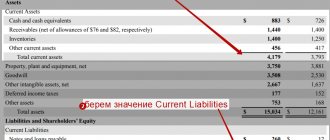Details
The authorized capital of a legal entity is the initial provision of the organization’s activities by contributing funds (property, securities) by owners or shareholders.
Note from the author! The size of the authorized capital undergoes the procedure of official state registration and is displayed in the constituent documentation of the company; the data in the financial statements and documents must be identical.
Depending on the organizational and legal form of legal entities, a certain procedure for the formation of the initial property of the organization is established:
- JSC: authorized capital - the nominal value of shares purchased by shareholders.
The minimum amount for a PJSC is 100 thousand rubles, a non-public company is 10 thousand rubles. - LLC: authorized capital - the initial amount of funds contributed by the founders.
Minimum amount: 10 thousand rubles, funds must be deposited within 4 months from the date of state registration of the company.Note from the author! The initial deposit can be formed not only in cash, but also in tangible assets (fixed assets, goods, etc.), securities. When making a contribution with property, its value must be assessed by an independent appraiser.
- State and municipal unitary enterprises: the formed fund is the minimum amount of initial property that ensures the interests of potential creditors of the organization.
The minimum amount of the fund for a government institution: not less than 5,000 minimum wages established by the government on the date of registration.The minimum amount of the fund for municipal enterprises: not less than 1000 minimum wages established by the government on the date of registration.
Note from the author! From January 1, 2021, the Federal Law established the minimum wage at 9,489 rubles. Regions have the right to apply federal laws to determine the minimum wage for employees. From May 1, 2021, the minimum wage will be 11,163 rubles.
Line 1310 of the balance sheet of the financial statements belongs to the Capital and liability reserves section of the balance sheet: information on the state of the authorized capital of the organization as of December 31 of the current year, the previous year and the previous one is displayed here. The data must completely match the registered constituent documentation.
Note! In the financial statements, the amount of the authorized capital is reflected in full, regardless of whether it has been paid at the moment.
Common entries for the formation and adjustment of authorized capital
- Formation of the authorized capital of a legal entity
- Increase the authorized capital
Dt84 Kt80 - at the expense of profit.Dt82, 83 Kt80 - using additional or reserve funds.
Dt50,51,52,55,01,41 Kt80 – contribution of funds and property as contributions to a simple partnership.
Note from the author! In LLCs and JSCs, contributions from founders and shareholders are reflected in accounting in correspondence with Kt account 75 (for example, Dt51 Kt75 - crediting the owner's contribution to the current account).
- Reducing the fund size
Dt75 Kt80 – reduction of the nominal value of shares, reduction of the founder’s share in the company.Dt80 Kt81 – cancellation of own shares purchased from shareholders.
Dt80 Kt84 – equalization of the company’s net assets with the amount of the authorized capital by writing off losses.
Dt80 Kt50,51,55,01,41 – return of property to partners operating under a simple partnership agreement.
>Questions and answers on the topic
No questions have been asked about the material yet, you have the opportunity to be the first to do so
Save the article to social networks:
Common entries for transactions with an additional fund formed in the organization
- Formation of the company's additional fund:
Dt01 Kt83 – due to positive revaluation of non-current assets.Dt75 Kt83 – due to share premium arising from a positive difference between the sale price of securities to shareholders and their nominal value. Also, this accounting entry serves as a reflection of positive exchange rate differences on deposits of the company’s founders, which are denominated in foreign currency.
Dt86 Kt83 – at the expense of funds received for targeted financing of the organization’s activities.
- Spending of the company's additional capital:
Dt83 Kt80 – making a decision to increase the authorized capital of the organization at the expense of the company’s own assets, incl. means of additional capital.Dt83 Kt75 – use of fund funds to pay off emerging obligations when settling accounts with the founders, for example, when reducing the size of the authorized capital. Also, this entry in accounting is a reflection of negative exchange rate differences on contributions from the founders of the company, which are denominated in foreign currency.
Line 1350 “Additional capital (without revaluation)”
Line 1350 reflects the amount of additional capital of the organization, with the exception of the amounts of additional valuation of non-current assets:
(except for the amounts of additional valuation of fixed assets and intangible assets)
Additional capital can be formed through:
· share premium, which is the amount of the difference between the sale and par value of shares (shares), received in the process of forming the authorized capital of the organization (upon the establishment of the organization, with a subsequent increase in the authorized capital) through the sale of shares (shares) at a price exceeding the par value;
· exchange rate differences associated with settlements with founders on deposits, including contributions to the authorized (share) capital of an organization, expressed in foreign currency;
· the difference arising as a result of the recalculation of the value of the assets and liabilities of the organization, expressed in foreign currency, used to conduct activities outside the Russian Federation, into rubles;
· contributions to the property of a limited liability company;
· the amount of VAT recovered by the founder when transferring property as a contribution to the authorized capital and transferred to the established organization (if the specified amounts are not a contribution to the authorized capital of the established organization).
Line 1360 “Reserve capital”
Line 1360 reflects the amount of the organization’s reserve capital, formed both in accordance with the constituent documents and in accordance with the law:
(except for special funds to finance current expenses)
Plus
(in terms of special funds (with the exception of special funds for financing current expenses))
Line 1370 “Retained earnings (uncovered loss)”
Line 1370 reflects the amount of retained earnings or uncovered loss of the organization:
Interim reporting:
Plus/minus
Minus
(in terms of interim dividends accrued in the reporting period)
Annual reporting:
The amount of retained profit (uncovered loss) of the reporting period is equal to the amount of net profit (net loss) of the reporting period, i.e. profit (loss) after tax. Therefore, if the organization does not have retained earnings (uncovered loss) from previous years and the distribution of interim dividends during the reporting period, then the value of line 1370 coincides with the value of line 2400 “Net profit (loss) of the reporting period” of Form No. 2.
Line 1300 “Total for Section III”
Line 1300 reflects the sum of indicators on lines with codes 1310 - 1370 and reflects the total amount of the organization’s capital:
Sum of lines: 1310 “Authorized capital (share capital, authorized capital, contributions of partners)” 1340 “Revaluation of non-current assets” 1350 “Additional capital (without revaluation)” 1360 “Reserve capital” Minus 1320 “Own shares purchased from shareholders” plus/ minus 1370 “Retained earnings (uncovered loss)”
Line 1410 “Borrowed funds”
Line 1410 reflects information on the status of long-term (for a period of more than 12 months) loans and borrowings received by the organization:
Line 1420 “Deferred tax liabilities”
Line 1420 reflects information about deferred tax liabilities:
When preparing financial statements, an organization is given the right to reflect in the balance sheet the balanced (collapsed) amount of a deferred tax asset and a deferred tax liability.
Reflection in the balance sheet of the balanced (collapsed) amount of a deferred tax asset and a deferred tax liability is possible if the following conditions are simultaneously met: the presence of deferred tax assets and deferred tax liabilities in the organization; deferred tax assets and deferred tax liabilities are taken into account when calculating income taxes.
Minus
(! if the result is positive!
Capital and reserves
- Purpose of the article: displaying information about the availability of funds in the company’s additional fund. Exception: revaluation of a company's non-current assets.
- Line in the balance sheet: 1350.
- Account numbers included in the line: account credit balance 83.
Line 1350 of the balance sheet displays information about the amount of additional capital of the organization.
According to the current legislation, the main sources of its formation are identified:
- procedure for revaluation of non-current assets - increasing their initial value when bringing the value of property to market prices, for example, to attract additional financing for activities;
- the positive difference between the nominal value of a joint stock company's own securities and the price of their sale to shareholders is the organization's share premium.
Note from the author! According to the federal law on joint stock companies, the minimum size of the authorized capital of public companies is 100 thousand rubles; for non-public companies the minimum threshold is 10 thousand rubles. Any change in the size of the authorized capital is considered only after full payment of the initial amount.
In addition to joint stock companies, share premiums may arise from limited liability companies in cases where the shares of the founders are sold at a higher nominal value.
- Acceptance of targeted financing funds into the company's accounting records, the receipt of which is aimed, for example, at the purchase of fixed assets necessary for the successful functioning of the company, etc.
- positive exchange rate differences that may arise when revaluing assets and sources of their formation, expressed in foreign currency for the operation of a company abroad, into Russian rubles.
- positive exchange rate differences that may arise during the formation of the authorized capital of a company, when the founders or shareholders of the organization contribute their share in foreign currency and the exchange rate on the date of official registration of the size of the authorized capital is lower than the exchange rate on the day of the actual contribution of funds by the founder of the company;
- additional contributions of the founders of limited liability companies to the property of the company without changing the initially established size of the authorized capital.
Line 1350 of the balance sheet belongs to the section Capital and reserves of the passive part of the balance sheet: information on credit 83 of the account should be reflected here - the amount of additional capital formed at the enterprise as of December 31 of the current year, the previous one and the previous one.
Something to keep in mind! Line 1350 displays the incomplete size of the organization's additional fund. That part of the capital that is formed through the revaluation of the company’s non-current assets is recorded in line 1340 of the balance sheet. In this regard, in-depth monitoring of the sources of fund formation is necessary.
Since this fund is formed as an additional fund, the funds are not used in the main activities of the organization. The formation of additional capital is necessary in the following cases:
- making a decision to increase the authorized capital of the organization using the additional fund;
- repayment of the decrease in the price of non-current assets resulting from the revaluation procedure;
- negative exchange rate differences that may arise when revaluing assets and sources of their formation, expressed in foreign currency for the operation of a company abroad, into Russian rubles;
- negative exchange rate differences that may arise during the formation of the authorized capital of a company, when the founders or shareholders of the organization contribute their share in foreign currency and the exchange rate on the date of official registration of the size of the authorized capital is higher than the exchange rate on the day of the actual contribution of funds by the founder of the company.
Common entries for transactions with an additional fund formed in the organization
- Formation of the company's additional fund:
Dt01 Kt83 – due to positive revaluation of non-current assets.Dt75 Kt83 – due to share premium arising from a positive difference between the sale price of securities to shareholders and their nominal value. Also, this accounting entry serves as a reflection of positive exchange rate differences on deposits of the company’s founders, which are denominated in foreign currency.
Dt86 Kt83 – at the expense of funds received for targeted financing of the organization’s activities.
- Spending of the company's additional capital:
Dt83 Kt80 – making a decision to increase the authorized capital of the organization at the expense of the company’s own assets, incl. means of additional capital.Dt83 Kt75 – use of fund funds to pay off emerging obligations when settling accounts with the founders, for example, when reducing the size of the authorized capital. Also, this entry in accounting is a reflection of negative exchange rate differences on contributions from the founders of the company, which are denominated in foreign currency.
Accounting for capital and reserves
Line 410 “authorized capital” reflects the authorized (share) capital in the amount recorded in the organization’s constituent documents and is reflected in accounting as a credit balance in account 80 “Authorized capital”.
The authorized (share) capital is a valuation of the contributions invested by the owners (participants, founders) in the organization’s property, and determines the minimum amount of the company’s property that guarantees the interests of its creditors.
The size of the authorized capital must correspond to the amount recorded in the organization’s constituent documents and be no less than the amount established by the legislation of the Russian Federation for organizations of various forms of ownership.
Reflection in accounting and reporting of data on an increase or decrease in the size of the authorized capital is carried out on the basis of amendments to the constituent documents of the organization and their registration.
The line “Own shares repurchased from shareholders” reflects the actual costs of the organization to repurchase its own shares from shareholders, i.e. debit balance on account 81 “Own shares (shares)”. The redemption amount is reflected in parentheses and reduces the authorized capital indicator.
Line 420 “Additional capital” reflects the credit balance of account 83 “Additional capital”.
Additional capital reflects the sources of increase in the value of the organization's non-current assets as a result of their revaluation, as well as the amount of share premium, which is the excess of the market value of the distributed shares over their par value.
Additional capital also includes exchange rate differences associated with the formation of the authorized (share) capital of the organization, and targeted funds that were spent by the non-profit organization to finance long-term investments.
Analytical accounting for account 83 “Additional capital” is carried out according to the sources of formation and directions of use of additional capital; in the working chart of accounts it is advisable to maintain sub-accounts:
- “Increase in property value due to revaluation”;
- "Share premium";
- "Other supply".
Additional capital in the form of share premium and other income is a component of the organization's invested capital.
Line 430 “reserve capital” reflects the credit balance in account 82 “Reserve capital”. Reserve capital is part of the accumulated capital of the organization. The source of formation of reserve capital for organizations of all legal forms is retained earnings.
Reserve capital is intended to cover losses, repay the company's bonds and repurchase the company's shares in the absence of other funds. This balance sheet item is deciphered as follows: separate lines show the amounts of reserves formed in accordance with the law and reserves formed in accordance with the constituent documents of organizations.
Source: https://velereya.ru/kapital-i-rezervy/
Simplified balance sheet. The procedure for filling out the balance sheet and financial performance report
)
Deferred tax liability is a part of deferred income tax, which should lead to an increase in income tax payable to the budget in the next reporting period or in subsequent reporting periods.
Deferred tax asset is a part of deferred income tax, which should lead to a reduction in income tax payable to the budget in the next reporting period or in subsequent reporting periods.
A deferred tax liability is formed when taxable temporary differences arise (expenses in accounting are less than in tax accounting).
| Deferred tax liabilities | = | Taxable temporary differences | X | Income tax rate |
Line 1430 “Estimated liabilities”
Line 1430 reflects the amounts of estimated liabilities, the expected fulfillment period of which exceeds 12 months:
An estimated liability is recognized in accounting if the following conditions are simultaneously met:
· the organization has an obligation resulting from past events in its economic life, the fulfillment of which the organization cannot avoid. In the event that an organization has doubts about the existence of such an obligation, the organization recognizes a provision if, as a result of an analysis of all circumstances and conditions, including the opinions of experts, it is more likely than not that the obligation exists;
· a decrease in the economic benefits of the organization necessary to fulfill the estimated liability is likely;
· the amount of the estimated liability can be reasonably estimated.
Line 1450 “Other obligations”
Line 1450 reflects other liabilities of the organization whose repayment period exceeds 12 months:
Plus
Plus
Plus
Plus
Plus
Plus
In the balance sheet, assets and liabilities should be presented with a division depending on their maturity (maturity) into short-term and long-term. Assets and liabilities are presented as short-term if their maturity (maturity) period is no more than 12 months after the reporting date or the duration of the operating cycle, if it exceeds 12 months. All other assets and liabilities are presented as non-current.
Didn't find what you were looking for? Use Google search on the site:
Explanation of balance sheet lines for accounts
It can be carried out by increasing the value of the company’s property, through additional contributions from participants, or through contributions from third parties accepted into the company (if the latter is allowed by the Charter).
If at the end of the second and each subsequent financial year the value of the LLC’s net assets is less than its authorized capital, the company is obliged to register a decrease in its authorized capital to an amount not exceeding the value of its net assets. An LLC is subject to liquidation if the value of its net assets is less than the minimum amount of authorized capital established by the Federal Law “On Limited Liability Companies” as of the date of state registration of the company.
An increase in the authorized capital of a joint stock company (JSC) can be done by increasing the par value of shares or by placing additional shares. If at the end of the second and each subsequent financial year the value of the net assets of the JSC is less than the minimum authorized capital specified in the Federal Law “On Joint Stock Companies”, the JSC is subject to liquidation.
useful links
►Economic literature◄ ►Methodology of financial analysis◄ ►Manual on financial statements◄ ►The largest joint stock companies in Russia◄
Line 1310 “Authorized capital (share capital, authorized capital, contributions of partners)”
Line 1310 reflects the amount of the authorized capital (share capital, authorized fund) of the organization:
This line reflects the amount of authorized (share) capital registered in the constituent documents as a set of contributions (shares, shares, shares) of the founders (participants) of the organization.
The authorized (share) capital and the actual debt of the founders (participants) for contributions (contributions) to the authorized (share) capital are reflected in the balance sheet separately.
State and municipal unitary enterprises, instead of authorized (share) capital, take into account the authorized capital formed in the prescribed manner.
An increase in the authorized capital of a limited liability company is permitted only after its full payment.
An increase in the authorized capital of a limited liability company may be carried out at the expense of the company’s property, and (or) at the expense of additional contributions of the company’s participants, and (or), if this is not prohibited by the company’s charter, at the expense of contributions from third parties accepted into the company.
If at the end of the second and each subsequent financial year the value of the net assets of a limited liability company is less than its authorized capital, the company is obliged to announce a reduction in its authorized capital to an amount not exceeding the value of its net assets and register such a decrease in the prescribed manner.
If at the end of the second and each subsequent financial year the value of the company’s net assets is less than the minimum amount of authorized capital established by the Federal Law “On Limited Liability Companies” as of the date of state registration of the company, the company is subject to liquidation.
The authorized capital of a joint stock company can be increased by increasing the par value of shares or placing additional shares.
If at the end of the second and each subsequent financial year, in accordance with the annual balance sheet proposed for approval by the company’s shareholders, or the results of an audit, the value of the company’s net assets turns out to be less than the minimum authorized capital specified in the Federal Law “On Joint Stock Companies,” the company is obliged to accept decision on its liquidation.
| Item in the asset balance sheet of a simplified form | Balance of accounting accounts that are accounted for under this item | The corresponding asset item of the balance sheet in the generally accepted form | Line code |
| Tangible non-current assets | Account 08 (according to the corresponding subaccounts) + Account 01 + Account 03 – Account 02 | Fixed assets | |
| Unfinished capital investments | |||
| Profitable investments in material assets | |||
| Material prospecting assets | |||
| Intangible, financial and other non-current assets | Account 08 (according to the corresponding subaccounts) + Account 04 + Account 05 + Account 58 + Account 55 (deposit accounts) – Account 59 + Account 09, etc. | Intangible assets | |
| Research and development results | |||
| Intangible search assets | |||
| Financial investments | |||
| Deferred tax assets | |||
| Other noncurrent assets | |||
| Reserves | Account 10 + Account 11 + Account 15 +/- Account 16 + Account 20 + Account 21 + Account 23 + Account 28 + Account 29 + Account 41 + Account 42 + Account 43 – Account 14 + Account 44 + Account 45 + Account 97 | Reserves | |
| Cash and cash equivalents | Account 50 + Account 51 + Account 52 + Account 55 (except for time deposits) + Account 57 | Cash and cash equivalents | |
| Financial and other current assets | Account 58 + Account 55 (deposits) – Account 59 + Account 19 + Debit Account 60,62,68,69, 70,71,73,75,76 – Account 63 | Accounts receivable | |
| Financial investments (excluding cash equivalents) | |||
| Other current assets |
Now let’s take a closer look at the reflection of balances and turnover, which accounts are used to make up the Balance Sheet for small enterprises (Table 1.2).
Table 1.2
Formation of lines of a simplified balance sheet of a small enterprise
| Indicator name | Formation of meaning |
| Assets | |
| Line 1150 “Tangible non-current assets” | The line is calculated as the difference between the Balance at the end of the period for the Debit of account 01 and the Balance at the end of the period for the Credit of account 02. |
| Line 1190 “Intangible, financial and other non-current assets.” | The line is calculated as the difference between the Amount of balances at the end of the period for the Debit of accounts 03,04,09,58 and the Amount of balances at the end of the period for the Credit of accounts 05,59. |
| Line 1210 “Inventories”. | The line is calculated as the difference between the Amount of balances at the end of the period for Debit accounts 10,11,15,16.1,20,21,23,25,26,29,41,43,44,45,46,97 and the Amount of balances at the end of the period for Credit accounts 14, 16.1,16.2,42. |
| Line 1250 “Cash and cash equivalents.” | The line is calculated as the sum of the Balances at the end of the period for the Debit accounts 50,51,52,55,57. |
| Line 1260 “Financial and other current assets.” | Line 1260 is calculated as the Sum of balances at the end of the period for Debit accounts 19,60,62,66,67,68,69,70,71,73,75,76,79,86,94 minus Balance for Credit account 63. |
| Passive | |
| Line 1310 “Capital and reserves” | The line is calculated as the Sum of balances at the end of the period for Account Credit 80,82,83,84 minus Account Credit Balance 81. |
| Line 1410 “Long-term borrowed funds.” | The line is calculated as the Balance at the end of the period for Account Credit 67. |
| Line 1450 “Other long-term liabilities.” | The line is calculated as the sum of the balances at the end of the period for the Credit of accounts 75.77. |
How to fill out section III
We present in the table information about which accounting accounts are used to fill out the indicators in Section III “Capital and Reserves” of the balance sheet (Order of the Ministry of Finance dated October 31, 2000 No. 94n). In this case, for example, “K80” will mean the credit balance of account 80 “Authorized capital” as of the reporting date, and, accordingly, “D81” will mean the debit balance of account 81 “Own shares (shares)” as of the same date:
| Indicator name | Code | Which account data is used? | Algorithm for calculating the indicator |
| Authorized capital (share capital, authorized capital, contributions of partners) | 1310 | 80 | K80 |
| Own shares purchased from shareholders | 1320 | 81 | D81 (shown in parentheses on the balance sheet) |
| Revaluation of non-current assets | 1340 | 83 “Additional capital” | K83 (in terms of amounts of additional valuation of non-current assets) |
| Additional capital (without revaluation) | 1350 | 83 | K83 (except for amounts of additional valuation of non-current assets) |
| Reserve capital | 1360 | 82 “Reserve capital” | K82 |
| Retained earnings (uncovered loss) | 1370 | 99 “Profits and losses”, 84 “Retained earnings (uncovered loss)” | Or K99 + K84 Or D99 + D84 (the result is reflected in parentheses) Or K84 - D99 (if the value is negative, reflected in parentheses) Or K99 - D84 (if the value is negative, reflected in parentheses) |
Please note that money and other property received from participants to increase the authorized capital, before registering changes to the charter, is shown under a separate article in Section III (Letter of the Ministry of Finance dated 02/06/2015 No. 07-04-06/5027).
In addition, interim dividends paid during the year are reflected separately in Section III. They are shown in parentheses, for example, on line 1371 "incl. interim dividends" (Letter of the Ministry of Finance dated December 19, 2006 No. 07-05-06/302).
Information in section III, as well as for other sections of the balance sheet, is presented simultaneously in 3 columns (Order of the Ministry of Finance dated July 2, 2010 No. 66n):
- at the reporting date;
- as of December 31 of the previous year;
- as of December 31 of the year preceding the previous one.
Preparing financial statements of small businesses in a simplified version makes the work of an accountant easier, but requires the user to understand what information is contained in each line of the reporting forms. For example, capital and reserves in a simplified balance sheet are information about all types of equity capital of the company reduced to one figure. It is located in the third section of the balance sheet under code 1300. Let's figure out which accounts the accountant operates when filling out line 1300 of the simplified balance sheet, which accumulates all types of capital of the company.
Line 1310 “Authorized capital
Line 1510 “Short-term borrowed funds”. The line is equal to the Balance at the end of the period on the Credit of accounts 66. Line 1520 “Accounts payable”. The line is calculated as the sum of the balances at the end of the period on the Credit of accounts 60,62,68,69,70,71,73 ,75,76.Line 1550 “Other short-term liabilities.”The line is calculated as the sum of the balances at the end of the period under the Credit of accounts 96.98.The income statement shows the financial results of the organization for the reporting period.
In the simplified form of the financial results statement, there are no items of commercial and administrative expenses, gross profit, interim results of profit (loss) from sales, profit (loss) before tax, reference information about individual income and expenses, the total financial result of the period, etc.
Let's take a closer look at balances and turnover, for which accounts the Financial Results Report for small businesses is compiled (Table 1.3.).
Table 1.3
Formation of lines of a simplified report on the financial results of a small enterprise
| Indicator name | Formation of meaning |
| Line 2110 “Revenue, minus VAT, excise taxes.” | It is calculated as the difference between the turnover on the Credit account 90.1 and the sum of the turnover on the Debit account 90.3,90.4,90.5. |
| Line 2120 “Expenses for ordinary activities” | The line is calculated as the sum of turnover in the Debit of account 90.2, excluding commercial selling expenses and administrative expenses. |
| Line 2330 “Interest payable” | The line is calculated as turnover in the Debit of account 91 in terms of interest expenses. |
| Line 2340 “Other income” | The line is calculated based on the Turnover on Account Credit 91 |
| Line 2350 “Other expenses” | The line is calculated based on the Turnover in the Debit of account 91, all other expenses are indicated with the exception of Interest payable (they are reflected on line 2330) |
| Line 2410 “Income taxes, including current income tax.” | This line indicates the amount of income tax indicated in account 68. |
| Line 2400 Net profit | = Revenue – Expenses for ordinary activities + Interest payable + Other income – Other expenses + (-) Income tax. |
On January 1, 2013, the explanatory note and the auditor's report on the reliability of the accounting (financial) statements, confirming the reliability of the accounting (financial) statements, are not included in these statements.
If explanations are needed for the balance sheet and financial performance report, a small business entity draws up an appendix that provides the most important information, without knowledge of which it is impossible to assess the financial results of activities. In particular, the application can disclose the following information:
a) method of accounting for income and expenses;
b) significant errors of previous years identified and corrected in the reporting period;
c) accrual and payment of dividends to the founders;
d) changes in the authorized capital, etc.
Thus, having considered the main aspects of the formation of simplified financial statements of small enterprises, the following conclusions can be drawn.
The labor intensity of filling out accounting reporting forms for small businesses is much lower; there is no need to maintain a large accounting service at the enterprise. However, aggregation of balance sheet and income statement items into large subsections reduces their information content. It is difficult for analysts and investors to analyze the financial and economic activities of the enterprise of interest without additional transcripts to the statements.
Targeted financing in accounting
Usually the following are financed in a targeted manner:
- Design, survey and research work;
- Capital construction;
- Various special campaigns or ongoing activities (for example, repayment of debts to creditors);
- Technical re-equipment of production;
- Reimbursement of expenses incurred.
Investment of targeted funds from any sources is formalized by an agreement that reflects all the conditions that are mandatory for receiving and using financing, as well as defining a clear project framework and methods for controlling spending. These circumstances dictate separate accounting (analytical and synthetic) for each funded project.
Operations on targeted financing and its expenditure are combined on account 86 “Targeted financing” (TF). The credit of account 86 from the debit of account 76 records the receipt of funds, and the debit records their use in connection with the accounts:
- Production (accounts 20, 26) - with funding from NPOs;
- Additional capital (account 83) - with TF in the form of financial investments;
- Deferred income (FPI) on the account. 98 - when financing the acquisition of assets or current costs. Upon expenditure of these funds, the TF amounts attributable to them are transferred to the company’s income (accounts 90/1, 91/1).
Those. The credit balance of account 86 indicates the balance of unused target funds, the credit turnover records the volume of such receipts, and the debit balance indicates their use for planned needs. Basic operations are recorded by records:
| Operations | D/t | K/t |
| Receipt of targeted funding | 76 51 | 86 76 |
| Use of funds from the Central Fund for the purchase of fixed assets, intangible assets, goods and materials, payment of bills, payment of salaries | 08,10,60,70 | 60, 51 |
| Entering fixed assets or intangible assets acquired at the expense of the Central Fund into the corresponding assets | 01,04 | 08 |
| The use of financial funds in the form of financial investments is reflected | 86 | 83 |
| When financing current expenses, funds are accumulated in the account. 98, and as they are used, the amounts are transferred to the company’s income | 86 98 | 98 91/1 |
| Return of unused funds | 86 | 51 |
Withdrawal of financing is recognized as the formation of accounts payable subject to repayment. In this case, previously recognized income from targeted assistance should be written off as expenses. The amount of repaid financing is credited to the settlement accounts (account 76), and its excess over the balance of the unused amount becomes an expense and is included in losses.







